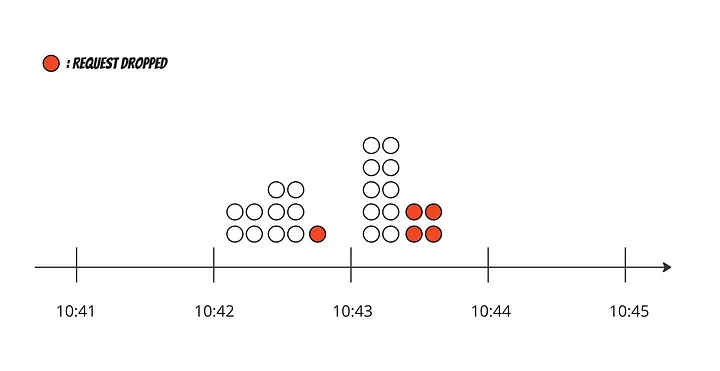Rate Limiting Algorithms: Fixed Window
Rate Limiting Algorithms: Fixed Window
Rate limiting is a mechanism used to control the number of requests that a client can perform in a given period of time. Its primary goals are to protect systems from overload, prevent abuse (such as brute-force attacks or API misuse).
Here are some common rate limiting algorithms:
- Fixed Window
- Sliding Window
- Token Bucket
- Leaky Bucket
In this post, we will look at the “Fixed Window” algorithm.
Fixed Window Algorithm
The Fixed Window algorithm is rate limiting technique that divides time into fixed intervals (e.g., one minute or one second). A counter will track the number of requests during each interval, and further requests will be dropped after the counter reaches the maximum limitation.
The simple implementation is as follows:
1
2
3
4
5
6
7
8
9
10
11
12
13
14
15
16
17
18
19
20
21
22
23
24
25
26
27
28
29
30
31
32
33
34
35
36
37
38
39
40
41
42
43
44
45
46
import Foundation
class FixedWindowRateLimiter {
let limit: Int // Number of requests allowed within "windowSize" seconds
let windowSize: Int // Window (Interval) size in seconds
private var currentWindow: Int? = nil
private var currentCount: Int = 0 // Number of requests received in current window
init(limit: Int, windowSize: Int) {
self.limit = limit
self.windowSize = windowSize
}
func allowRequest(_ timestamp: TimeInterval) -> Bool {
let timestampInt = Int(timestamp)
let window = timestampInt - timestampInt % windowSize
if currentWindow != window {
currentWindow = window
currentCount = 1
} else {
currentCount += 1
}
if currentCount > limit {
return false
} else {
return true
}
}
}
let timestamps = [1.1, 1.5, 1.7, 1.8, 1.9, 2.0, 2.2]
let limiter = FixedWindowRateLimiter(limit: 3, windowSize: 2)
for timestamp in timestamps {
let result = limiter.allowRequest(timestamp)
print("allowRequest(\(timestamp)) == \(result)")
}
// allowRequest(1.1) == true
// allowRequest(1.5) == true
// allowRequest(1.7) == true
// allowRequest(1.8) == false
// allowRequest(1.9) == false
// allowRequest(2.0) == true
// allowRequest(2.2) == true
Pros and Cons
- Pros
- Simplicity: Easy to implement because it only requires counting within fixed intervals.
- Cons
- Burstiness at Boundaries: A client could make many requests at the very end of one window and immediately at the beginning of the next window, potentially doubling the allowed rate for a short period.
- Doesn’t distribute load evenly: It does not distribute the load evenly across the entire peroid; it only checks per window.
References
This post is licensed under CC BY 4.0 by the author.
